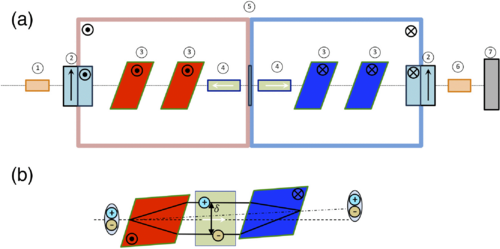There have been various theories suggested in the literature that include the presence of spin-dependent gravity interactions. These interactions could be mediated by particles that are sometimes referred to as WISPs (weakly interacting sub-eV particles); in quantum field theory, force carriers or messenger particles such as bosons give rise to forces between other particles.
A number of different experiments have looked for a spin-dependent gravity effect or new spin-dependent interactions. This study used spin echo small angle neutron scattering (SESANS) on Offspec to look for longer-range exotic spin-dependent interactions of neutrons than those previously sought.
The SESANS neutron spin echo spectrometer coherently splits and recombines the neutron path through an interferometer using a series of shaped magnetic fields. The neutrons in these two beams have opposite spins and is therefore well-suited to look for neutron spin-dependant effects.

Figure, reproduced with permission from DOI: 10.1103/PhysRevD.101.122002, Pictorial representation of the Offspec setup showing the beam line components and magnetic field orientations in (a), these are (1) polarizer, (2) v-coil (π/2 rotation), (3) rf flippers with shaped pole shoes, (4) Drabkin flipper with longitudinal magnetic field, (5) field stepper, (6) analyzer and (7) detector. In (b) is shown the operation of OffSpec.
Rather than using the experiment in its usual horizontal configuration, the group rotated the instrument so that one neutron path was higher than the other. This uncommon technical capability made Offspec the best place in the world to search for spin-dependent effects of the Earth's gravitational pull on the neutron wave function.
Their results did not show the presence of any exotic spin-dependent couplings. In principle, the precision of this measurement could be improved with more extensive control of the magnetic field environment of the apparatus.
Further information
The full paper can be found online at DOI: 10.1103/PhysRevD.101.122002
